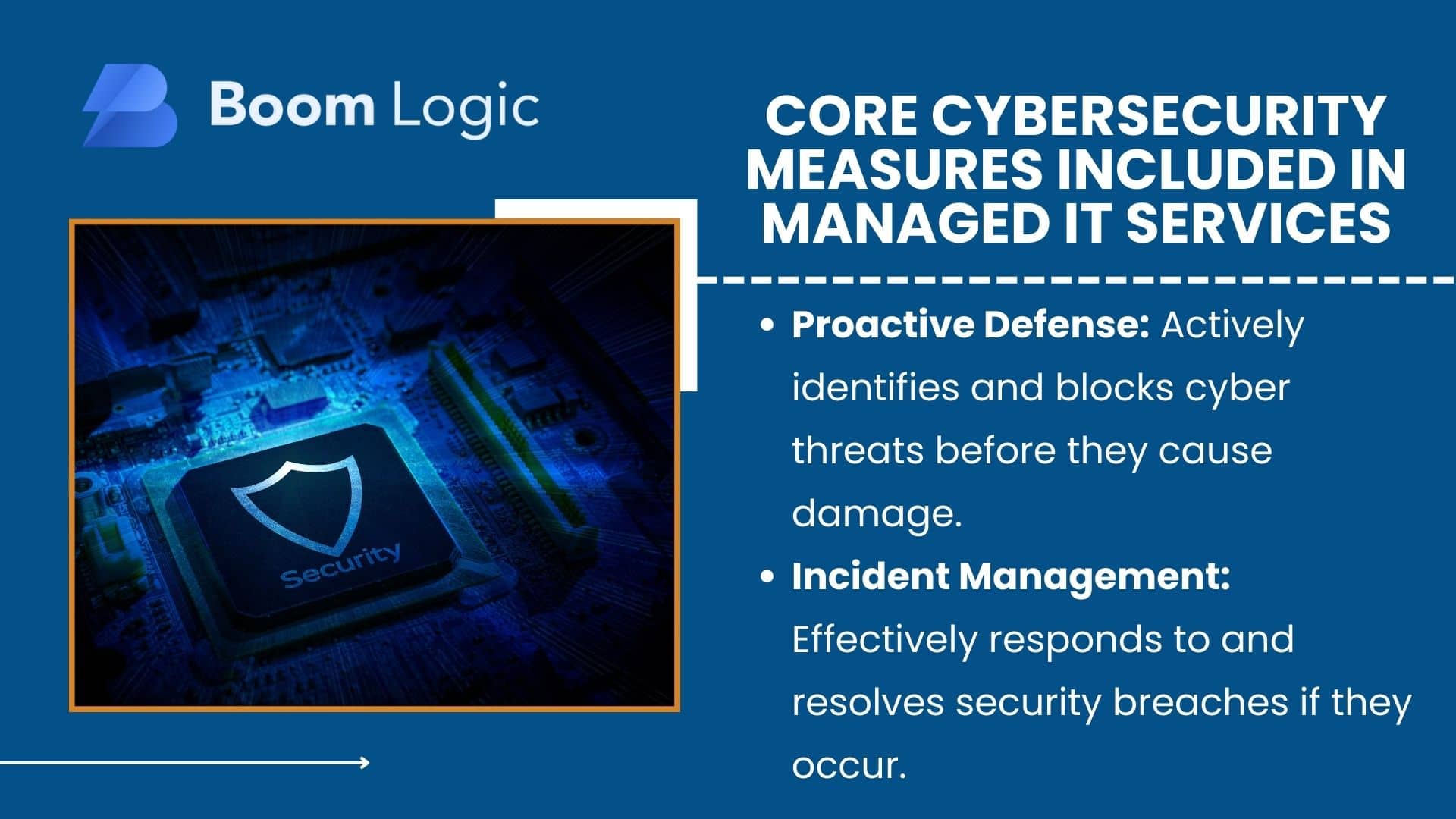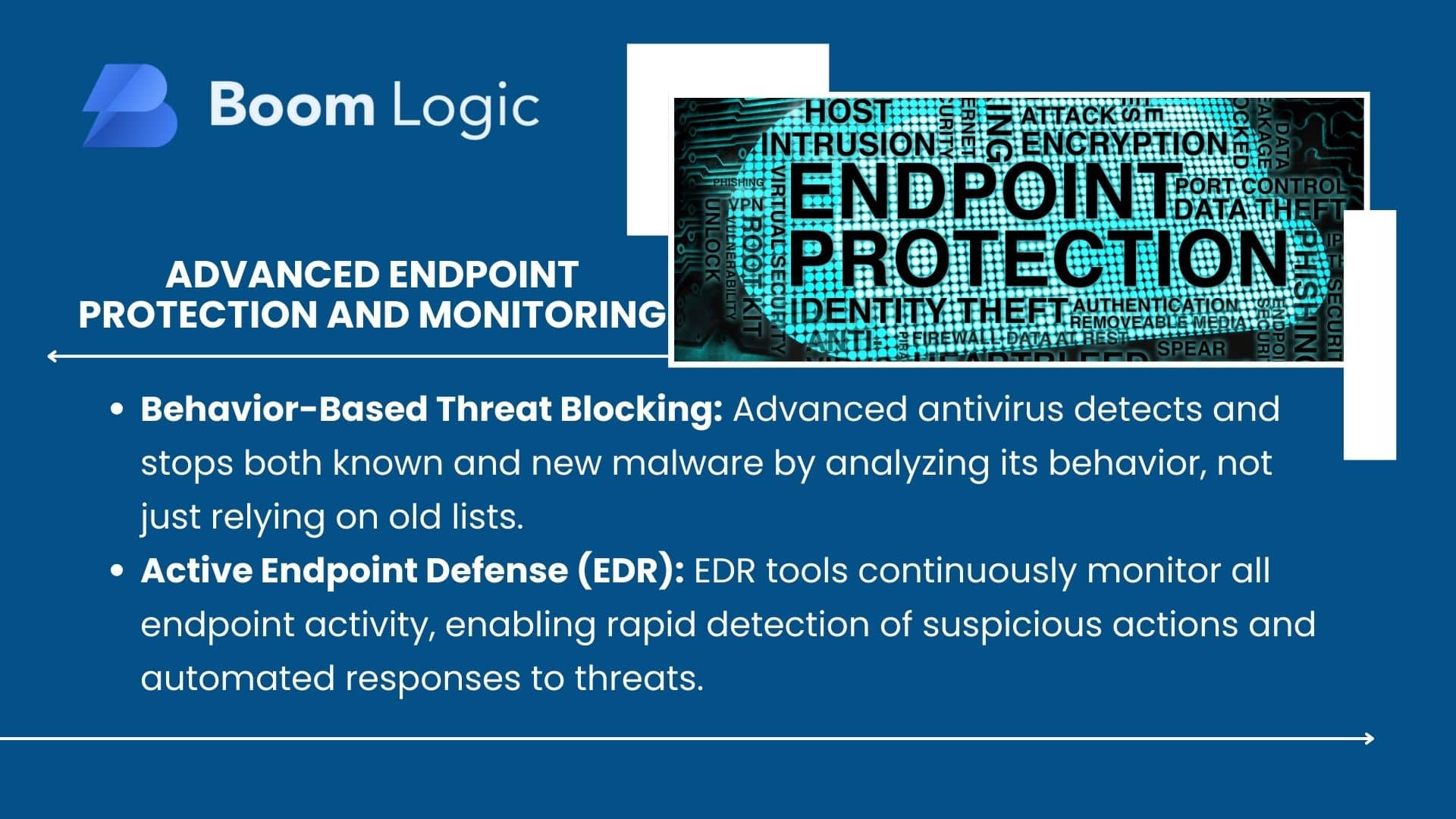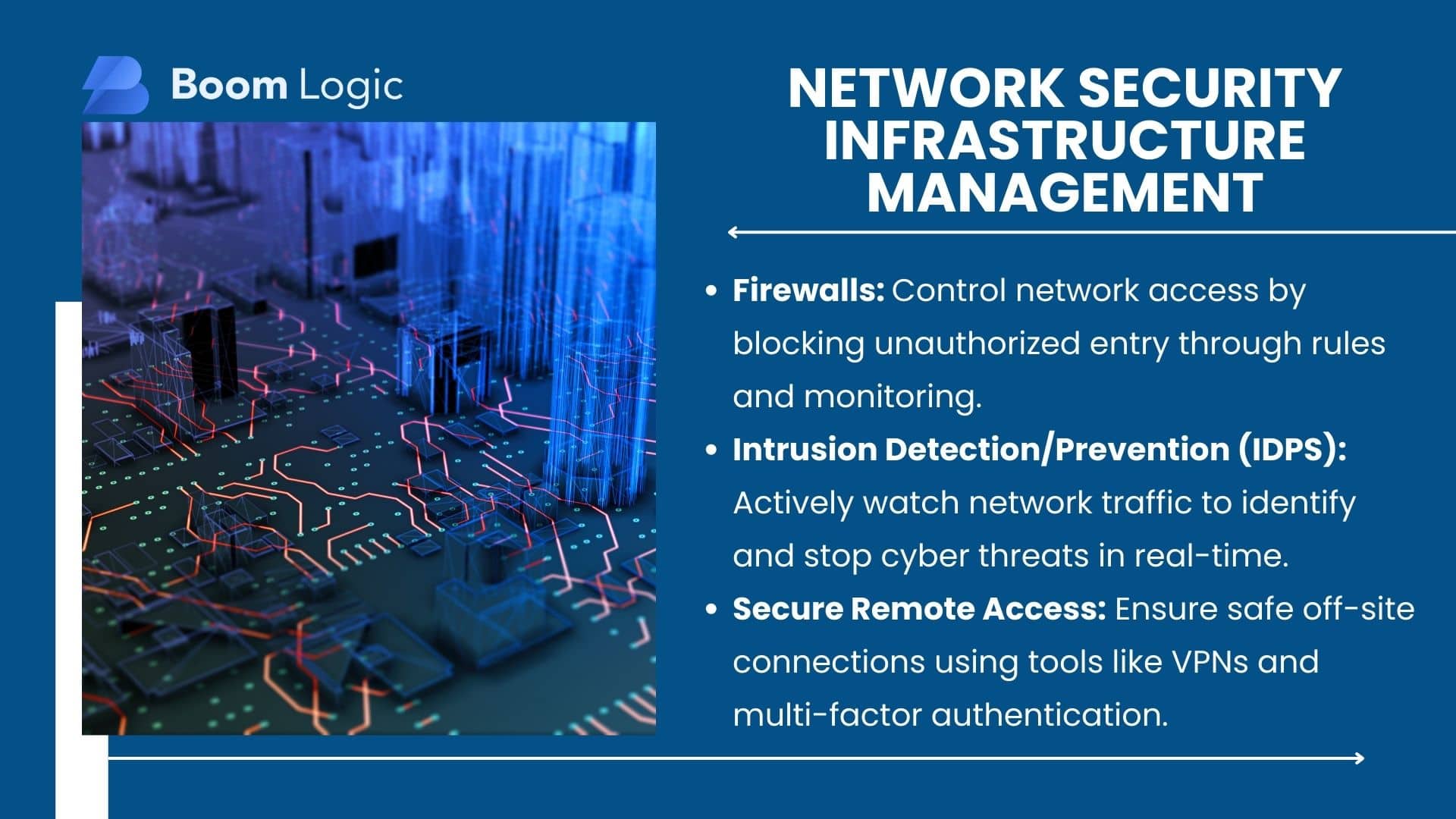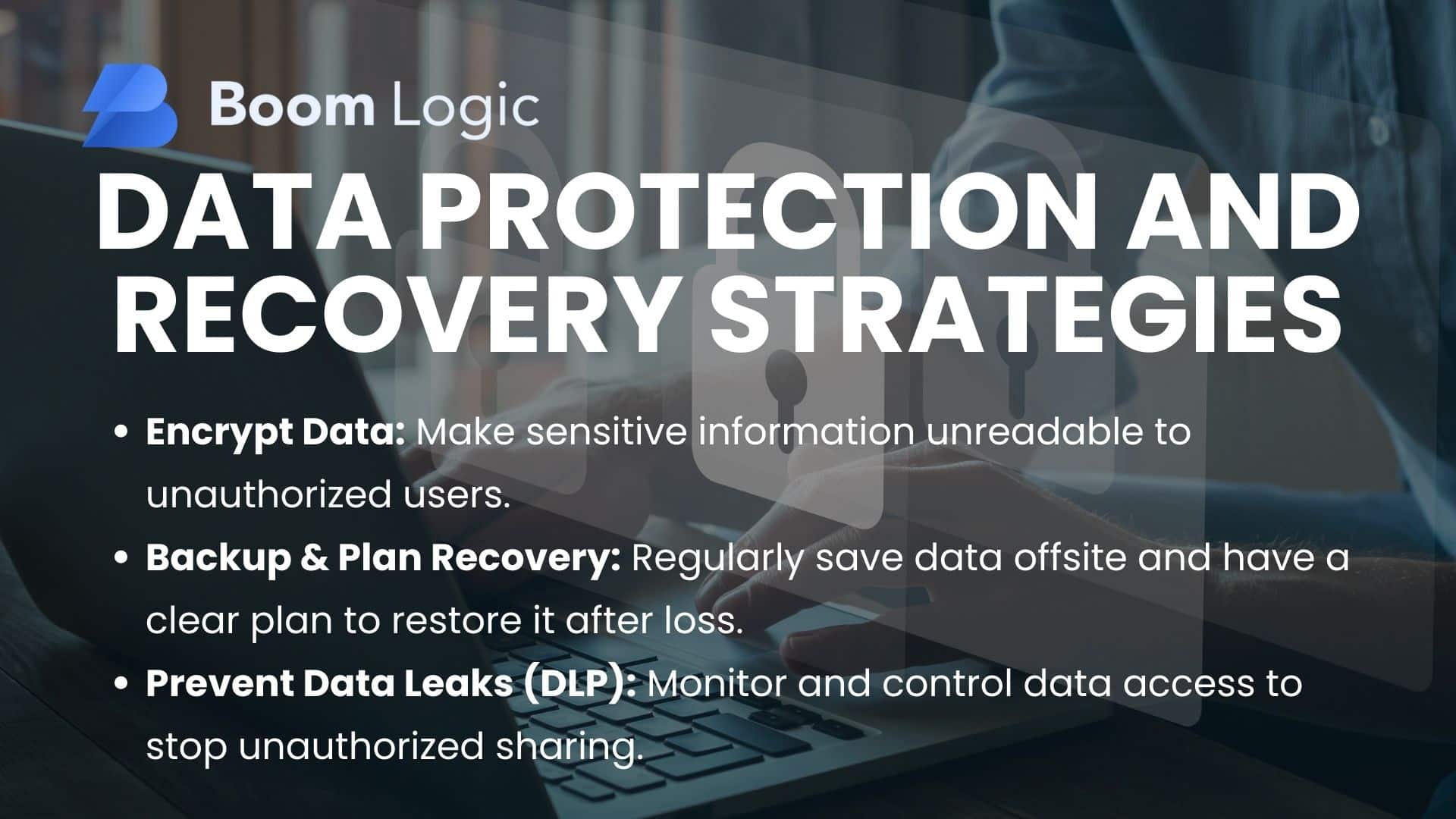In today’s digital landscape, businesses face an ever-evolving array of cybersecurity threats that can compromise sensitive data, disrupt operations, and cause significant financial damage.
According to a 2024 Sophos report, hackers are taking more advantage of unpatched vulnerabilities as entry points, conducting attacks more quickly with decreased “dwell time,” and getting better at subverting legitimate IT tools to conduct attacks. To combat these threats, businesses in Los Angeles, Pasadena, and Burbank need a comprehensive security strategy.
Boom Logic provides a robust managed service that includes multiple layers of protection to safeguard business data and systems from modern cyber threats.
Key Takeaways
- Boom Logic’s managed IT services include robust cybersecurity measures to protect businesses from evolving threats.
- A layered security strategy is crucial for businesses to prevent, detect, and respond to cyberattacks.
- Boom Logic’s services are designed to help businesses in Los Angeles, Pasadena, and Burbank safeguard their data and systems.
- Comprehensive security measures are essential for mitigating the risks associated with cyber threats.
- Boom Logic’s managed IT services incorporate industry best practices and cutting-edge technologies.
The Growing Cybersecurity Threat Landscape for Businesses
Businesses today face a growing and evolving cybersecurity threat landscape. The increasing reliance on digital technologies has expanded the attack surface, making businesses more vulnerable to cybersecurity threats. As a result, the need for robust security measures has become paramount to protect business operations and sensitive data.
Why Small and Medium Businesses Are Targeted
Small and medium businesses are increasingly being targeted by cyber attackers. According to Verizon’s Data Breach Investigation Report in 2022, 100% of attacks on very small businesses (organizations with less than 100 employees) were financially motivated. These businesses often lack the robust security measures that larger corporations have in place, making them attractive targets for attacks seeking financial gain.
The limited resources and less sophisticated security infrastructure of small and medium businesses make them more susceptible to breaches. Cyber attackers exploit these vulnerabilities to gain unauthorized access to sensitive data and disrupt operations.
The Financial Impact of Cybersecurity Breaches
The financial consequences of cybersecurity breaches can be devastating for businesses. The costs extend beyond immediate monetary losses to include expenses related to incident response, business disruption, reputation damage, regulatory fines, and recovery efforts. Some of the direct and indirect costs include ransom payments, forensic investigations, system repairs, legal fees, business downtime, lost productivity, and damaged customer relationships.
- Data breaches involving sensitive customer information can lead to regulatory fines and legal liabilities.
- The reputational damage following a security incident can result in lost business opportunities and decreased customer trust.
- Recovery from cybersecurity breaches often requires significant investment in improved security measures and potentially new hardware or software systems.
Core Cybersecurity Measures Included in Managed IT Services

Boom Logic’s managed IT services encompass a comprehensive suite of cybersecurity measures designed to protect businesses from evolving threats. These measures are designed to be proactive, detecting and preventing threats before they can cause harm.
Proactive Threat Prevention Systems
Boom Logic’s proactive threat prevention systems are designed to identify and mitigate potential security risks before they become incidents. This includes implementing robust security protocols and utilizing advanced threat detection tools to monitor the network and systems for suspicious activity.
These proactive measures help prevent cybersecurity threats from compromising business operations, ensuring continuity and security.
Reactive Security Response Protocols
While prevention is crucial, Boom Logic’s managed IT services also include comprehensive reactive security response protocols that activate when potential security incidents are detected. These protocols involve monitoring for security incidents and responding to them, including identifying and analyzing the threat, containing and eradicating it, and then recovering from the incident.
Key components of these protocols include:
- Automated alert systems that notify security personnel of suspicious activities or potential system compromises.
- Incident classification frameworks to prioritize security events based on severity and potential impact.
- Containment procedures to isolate affected systems and prevent lateral movement of threats within the network.
- Forensic analysis capabilities for detailed investigation of security incidents.
- Remediation processes to remove threats and restore normal operations.
- Post-incident analysis to identify lessons learned and implement security improvements.
This comprehensive incident response plan ensures that Boom Logic’s clients receive timely and effective support in the event of a security incident, minimizing the impact on their business operations.
Advanced Endpoint Protection and Monitoring

Advanced endpoint protection and monitoring are critical components of Boom Logic’s managed IT services, designed to protect businesses from sophisticated cyber threats. Endpoint security has become a crucial aspect of overall cybersecurity strategy due to the increasing number of endpoint devices and the complexity of threats targeting them.
Next-Generation Antivirus and Anti-Malware Solutions
Boom Logic’s managed IT services include next-generation antivirus and anti-malware solutions that go beyond traditional signature-based detection. These advanced solutions utilize machine learning and behavioral analysis to identify and mitigate both known and unknown threats. By continuously monitoring endpoint activity, these systems can detect and respond to potential security incidents in real-time, significantly reducing the risk of infection and data breaches.
Next-generation antivirus solutions are particularly effective against modern malware that often employs sophisticated evasion techniques. These solutions can identify and block malicious activities based on their behavior, rather than relying solely on known signatures.
Endpoint Detection and Response (EDR) Capabilities
Endpoint Detection and Response (EDR) capabilities represent a significant advancement in security technology that Boom Logic implements as part of its managed IT services. EDR tools monitor endpoint and network events, recording the information in a central database for further analysis, detection, investigation, reporting, and alerting. This proactive approach enables Boom Logic to detect and respond to threats swiftly, minimizing the potential impact on the client’s business.
- EDR continuously monitors all endpoint activity for suspicious behaviors that might indicate a compromise, unlike traditional security tools that simply block known threats.
- When suspicious activity is detected, EDR solutions can automatically isolate affected endpoints from the network, preventing lateral movement and containing potential threats.
- Detailed telemetry data collected from endpoints provides security analysts with comprehensive visibility into system activities, enabling thorough investigation of security incidents.
By integrating EDR capabilities into their managed IT services, Boom Logic provides businesses with a robust defense against advanced threats, enhancing their overall security posture.
Network Security Infrastructure Management

Effective network security infrastructure management is crucial for protecting business networks from ever-evolving cyber threats. A well-managed network security infrastructure ensures the confidentiality, integrity, and availability of business data and resources.
Firewall Configuration and Management
Firewall configuration and management are critical components of network security infrastructure management. Boom Logic’s MSP team expertly configures and manages firewalls to prevent unauthorized access to business networks. This includes setting up firewall rules, monitoring firewall logs, and performing regular security audits to identify potential vulnerabilities.
By implementing a robust firewall configuration, businesses can significantly reduce the risk of cyber threats and protect their networks from malicious activity.
Intrusion Detection and Prevention Systems
Intrusion Detection and Prevention Systems (IDPS) play a vital role in identifying and preventing cyber threats in real-time. Boom Logic implements IDPS to monitor network traffic for signs of unauthorized access or malicious activity. When a potential threat is detected, the system alerts the MSP team, who can then take swift action to prevent the threat from materializing.
IDPS solutions are designed to identify and block sophisticated cyber threats, including zero-day attacks and advanced persistent threats. By leveraging IDPS, businesses can enhance their security posture and protect their networks from evolving cyber threats.
Secure Remote Access Solutions
Secure remote access solutions enable employees to safely connect to corporate networks and resources from outside the office. Boom Logic implements comprehensive secure remote access solutions, including Virtual Private Networks (VPNs), multi-factor authentication, and encrypted connections.
- Boom Logic’s secure remote access solutions ensure that employees can work from anywhere without compromising network security.
- Multi-factor authentication requirements prevent credential-based attacks, even if passwords are compromised.
- Device posture checking verifies that connecting devices meet security requirements before granting access to the network.
By implementing these measures, businesses can ensure that their remote work arrangements do not introduce new security risks, while maintaining the flexibility and productivity that remote work offers.
Data Protection and Recovery Strategies

Effective data protection and recovery strategies are essential for maintaining business continuity. Organizations must implement robust measures to safeguard their data against various threats.
Data Encryption Protocols
Data encryption is a critical security measure that protects sensitive information from unauthorized access. By encrypting data both in transit and at rest, organizations can ensure that even if data is intercepted or accessed by unauthorized parties, it will be unreadable without the decryption key.
Encryption protocols such as SSL/TLS and AES are widely used to secure data.
Backup and Disaster Recovery Planning
A comprehensive backup and disaster recovery plan is vital for ensuring that data can be recovered in the event of a disaster or data loss. This involves regular backups of critical data, storing backups in secure, offsite locations, and having a clear plan for restoring data and resuming operations.
| Backup Type | Frequency | Storage Location |
|---|---|---|
| Full Backup | Weekly | Offsite |
| Incremental Backup | Daily | Cloud Storage |
Data Loss Prevention (DLP) Measures
Data Loss Prevention measures are designed to protect sensitive information from unauthorized access or leakage. DLP tools monitor data access and usage, identifying and preventing potential data breaches. Key DLP measures include content inspection, policy-based controls, and user activity monitoring.
- Content inspection technologies identify sensitive information.
- Policy-based controls enforce security rules based on data classification.
- User activity monitoring tracks how protected data is accessed and used.
Security Awareness and Employee Training Programs
A robust cybersecurity posture includes comprehensive security awareness and employee training programs. These initiatives are crucial in preventing cyber threats that exploit human vulnerabilities.
Boom Logic’s approach to security awareness and employee training is multifaceted, focusing on both the technical and human aspects of cybersecurity. By educating employees on the latest cyber threats and best practices for security, organizations can significantly reduce their risk profile.
Phishing and Social Engineering Defense Training
Phishing and social engineering attacks are among the most common cyber threats faced by organizations today. Boom Logic’s training programs are designed to educate employees on how to identify and respond to these threats. The training includes:
- Recognizing phishing emails and other social engineering tactics
- Understanding the risks associated with divulging sensitive information
- Reporting suspicious activities to the appropriate personnel
By empowering employees with the knowledge to defend against these attacks, organizations can enhance their overall cybersecurity posture.
Security Policy Implementation and Compliance
Effective security policy implementation is critical to maintaining a secure environment. Boom Logic assists clients in developing and implementing comprehensive security policies tailored to their specific industry requirements and risk profile. Key aspects include:
- Clear communication of policy requirements
- Role-based training to ensure employees understand their security responsibilities
- Automated compliance monitoring to track adherence to policy requirements
Regular reviews and updates to these policies ensure they remain relevant and effective in the face of evolving cyber threats, supporting ongoing security awareness and compliance.
Continuous Security Monitoring and Incident Response
A well-planned incident response strategy enables businesses to respond quickly and effectively to security incidents. Boom Logic’s managed IT services include comprehensive incident response strategies tailored to each client’s specific environment and risk profile.
24/7 Security Operations Center (SOC) Services
Boom Logic provides 24/7 Security Operations Center (SOC) services, ensuring continuous monitoring and rapid response to security threats. This around-the-clock vigilance helps detect and mitigate potential security incidents before they cause significant damage.
The SOC team is equipped with advanced tools and technologies to identify and analyze security threats in real-time. By leveraging these capabilities, Boom Logic’s clients can benefit from enhanced security posture and reduced risk.
Threat Intelligence and Vulnerability Management
Effective threat intelligence and vulnerability management are critical components of a robust cybersecurity strategy. Boom Logic’s threat intelligence capabilities help identify potential security threats and vulnerabilities, enabling proactive measures to prevent attacks.
The following table outlines the key aspects of Boom Logic’s threat intelligence and vulnerability management services:
| Service | Description | Benefits |
|---|---|---|
| Threat Intelligence | Identifies potential security threats and vulnerabilities | Proactive measures to prevent attacks |
| Vulnerability Management | Assesses and prioritizes vulnerabilities for remediation | Reduced risk of security breaches |
| Risk Mitigation | Implements measures to mitigate identified risks | Enhanced security posture |
Incident Response Planning and Execution
Boom Logic develops comprehensive incident response plans tailored to each client’s specific environment, business requirements, and risk profile. These plans outline specific steps to be taken during a security incident, ensuring a swift and effective response.
The incident response plan includes clear role assignments, ensuring that everyone understands their responsibilities during an incident. Regular tabletop exercises and simulations test the effectiveness of response plans and team readiness, identifying areas for improvement.
By having a well-planned incident response strategy in place, businesses can minimize the impact of security incidents and ensure continuity of operations. Boom Logic’s MSP team provides both technical expertise and guidance throughout the incident response process.
How Boom Logic Delivers Comprehensive Cybersecurity for Los Angeles Businesses
With a strategic, multi-layered approach to security, Boom Logic protects businesses throughout Los Angeles, Pasadena, and Burbank from evolving cyber threats. As a trusted managed service provider, Boom Logic combines technical expertise with a deep understanding of local business environments to create tailored security solutions that address specific organizational needs.
Boom Logic’s holistic approach integrates preventative measures, detection capabilities, and response protocols into a cohesive security framework aligned with industry best practices and regulatory requirements. Regular security assessments identify potential vulnerabilities and security gaps, establishing clear roadmaps for continuous security posture improvement.
By implementing cybersecurity best practices across all aspects of IT management, Boom Logic helps Los Angeles area businesses reduce risk while maintaining operational efficiency. The company’s proactive approach to vulnerability management addresses potential security weaknesses before they can be exploited, significantly reducing the likelihood of successful attacks.
Boom Logic’s comprehensive security services scale with business growth, ensuring that security capabilities remain aligned with organizational needs as companies evolve. Through strategic partnerships with leading security technology providers, Boom Logic delivers enterprise-grade cybersecurity capabilities to businesses of all sizes throughout the Los Angeles region, ultimately enhancing their security posture and reducing risk.


